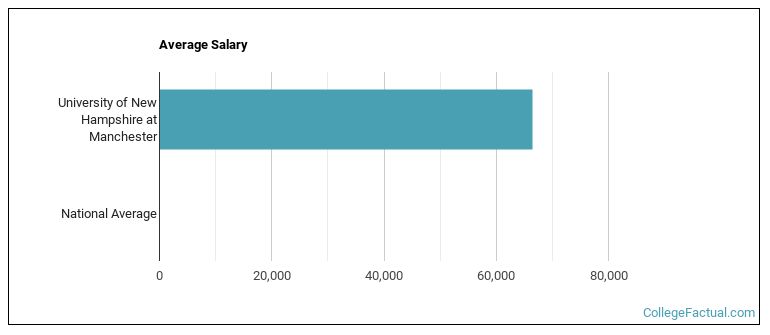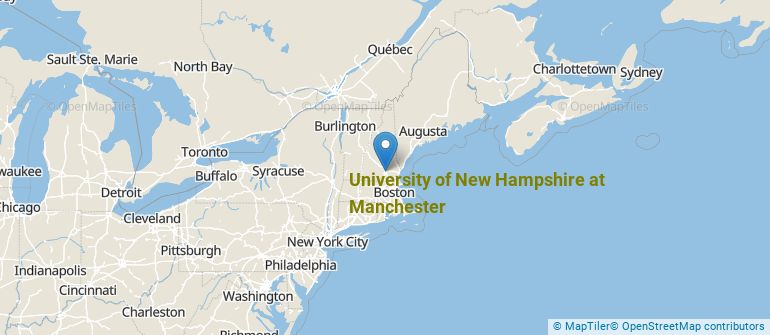 by our College Data Analytics Team
by our College Data Analytics TeamCollege Factual recognizes the best colleges and universities in its annual rankings. These rankings include categories for best overall colleges, best colleges for each major, best value schools, and much more.
University of New Hampshire at Manchester was awarded 2 badges in the 2025 rankings. The highest ranked major at the school is general biology.
Explore the best ranked schools for the programs you are most interested in.
College Factual ranked UNH Manchester as #752 out of 2,152 colleges and universities in the country on its 2025 Best Colleges list. This is an improvement over the previous year, when UNH Manchester held the #1,063 spot on the Best Overall Colleges list.
UNH Manchester also holds the #6 spot on the Best Colleges in New Hampshire ranking.
See all of the rankings for University of New Hampshire at Manchester.
With an acceptance rate of 85%, UNH Manchester has a fairly liberal admissions policy. However, don't just assume you'll get in! Put together a good application and make sure you include all requested documents and materials.
About 43% of students accepted to UNH Manchester submitted their SAT scores. When looking at the 25th through the 75th percentile, SAT Evidence-Based Reading and Writing scores ranged between 510 and 580. Math scores were between 530 and 590.
Learn more about University of New Hampshire at Manchester admissions.
At UNH Manchester, the student to faculty ratio is an excellent 7 to 1. That's much better than the national average of 15 to 1. This indicates that many classes will probably be small, and students will have ample opportunites to work closely with their professors and classmates.
In addition to the student to faculty ratio, some people look at what percentage of faculty members are full-time as a sign of how much time professors will be able to spend with their students. This is because part-time teachers may not be be on campus as much as their full-time counterparts.
The full-time faculty percentage at University of New Hampshire at Manchester is 36%. This is lower than the national average of 47%.
The freshmen retention rate tells us what percentage of first-year, full-time students choose to continue on to their sophomore year at a particular school. The rate at University of New Hampshire at Manchester is 65%, which is about average when compared to the national rate of 68%.
Students are considered to have graduated on time if they finish their studies within four years. At UNH Manchester the on-time graduation rate of first-time, full-time students is 55%. That is great when compared to the national average of 33.3%
Find out more about the retention and graduation rates at University of New Hampshire at Manchester.
During the 2017-2018 academic year, there were 704 undergraduates at UNH Manchester with 589 being full-time and 115 being part-time.
| $0-30 K | $30K-48K | $48-75 | $75-110K | $110K + |
|---|---|---|---|---|
| $13,360 | $13,047 | $15,881 | $21,050 | $23,806 |
The net price is calculated by adding tuition, room, board and other costs and subtracting financial aid.Note that the net price is typically less than the published for a school. For more information on the sticker price of UNH Manchester, see our tuition and fees and room and board pages.
Almost 66% of college students who graduated with the class of 2018 took out student loans, but that percentage varies from school to school. At UNH Manchester, approximately 54% of students took out student loans averaging $5,283 a year. That adds up to $21,132 over four years for those students.
Get more details about paying for University of New Hampshire at Manchester.

See which majors at University of New Hampshire at Manchester make the most money.
Get more details about the location of University of New Hampshire at Manchester.

Contact details for UNH Manchester are given below.
| Contact Details | |
|---|---|
| Address: | 88 Commercial Street, Manchester, NH 03101-1113 |
| Phone: | 603-641-4101 |
| Website: | manchester.unh.edu/ |
| Facebook: | https://www.facebook.com/UNHManchester |
| Twitter: | https://twitter.com/unhmanchester |
| Most Popular Majors | Bachelor’s Degrees | Average Salary of Graduates |
|---|---|---|
| General Business/Commerce | 29 | $57,378 |
| Biotechnology | 23 | $50,276 |
| General Biology | 22 | $45,346 |
| Communication & Media Studies | 16 | $43,551 |
| Other Public Administration | 16 | NA |
| Other Computer & Information Sciences | 15 | $57,256 |
| Neurobiology & Neurosciences | 13 | $39,573 |
| Homeland Security | 13 | $51,200 |
| General Psychology | 13 | $38,229 |
| Mechanical Engineering Technology | 12 | $64,826 |
Online learning options are becoming more and more popular at American colleges and universities. Online classes are great for students who have busy schedules or for those who just want to study on their own time.
In 2022-2023, 251 students took at least one online class at University of New Hampshire at Manchester. This is a decrease from the 557 students who took online classes the previous year.
| Year | Took at Least One Online Class | Took All Classes Online |
|---|---|---|
| 2022-2023 | 251 | 20 |
| 2021-2022 | 557 | 119 |
| 2020-2021 | 634 | 113 |
| 2018-2019 | 195 | 5 |
Learn more about online learning at University of New Hampshire at Manchester.
If you’re considering University of New Hampshire at Manchester, here are some more schools you may be interested in knowing more about.
Curious on how these schools stack up against UNH Manchester? Pit them head to head with College Combat, our free interactive tool that lets you compare college on the features that matter most to you!
Footnotes
*The racial-ethnic minorities count is calculated by taking the total number of students and subtracting white students, international students, and students whose race/ethnicity was unknown. This number is then divided by the total number of students at the school to obtain the racial-ethnic minorities percentage.
References
More about our data sources and methodologies.